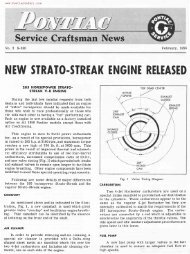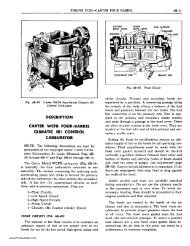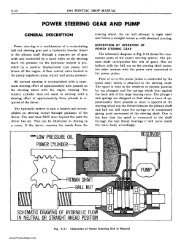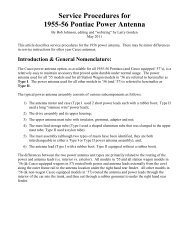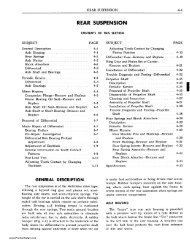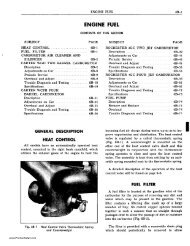Front Suspension
Front Suspension
Front Suspension
Create successful ePaper yourself
Turn your PDF publications into a flip-book with our unique Google optimized e-Paper software.
3-4 1955 PONTIAC SHOP MANUAL<br />
2. Check caster angle using any reputable front end<br />
aligning equipment. Specifications for caster are<br />
-1 0 +Yz o. When checking, it is necessary that readings<br />
be taken with car weight on the wheels, tires<br />
properly inflated, and vehicle level. Brakes must be<br />
held with a brake pedal depressor while checking<br />
caster.<br />
3. Do not change camber adjustment, if outside<br />
limits, until caster has been set.<br />
CHECKING CAMBER ANGLE<br />
1. Make sure operations under "Inspection Before<br />
Alignment" have been performed.<br />
Fig. 3-7<br />
Chalk mark in this position<br />
when checking caster, camber,<br />
king pin inclination<br />
Jounce Space Measurement<br />
Chalk mark in<br />
this position when<br />
checking toe-in and<br />
toe-out on turns<br />
location of point of greatest lateral run-out on<br />
front wheels when checking alignment factors<br />
Fig. 3-8<br />
Wheel Position for Checking Alignment<br />
Before checking front end alignment, jounce the<br />
car up and down at both the front and rear bumpers<br />
to make certain it is setting in its normal position.<br />
This is very important since caster and camber vary<br />
somewhat as the front of the car moves up and down.<br />
The specifications for front end alignment are based<br />
on the normal "curb weight" position of the car. Curb<br />
weight includes all equipment plus a full tank of gasoline.<br />
NOTE: Since the cars are quite frequently stiff<br />
when new, it is impossible to find the normal position<br />
by jouncing. For this reason, caster, camber and king<br />
pin inclination should not be checked on a new car<br />
until it is broken in.<br />
CHECKING CASTER ANGLE<br />
1. Make sure operations under "Inspection Before<br />
Alignment" have been performed.<br />
2. Check camber angle using any reputable front<br />
end aligning equipment. Specifications for camber<br />
are + Yz 0 -I-% o. When checking, it is necessary that<br />
readings be taken with car weight on the wheels, tires<br />
properly inflated, and vehicle level.<br />
3. Do not change camber adjustment, if outside<br />
limits, until caster has been set.<br />
CHECKING KING PIN INCLINATION<br />
If camber is correct or can be set to specifications,<br />
it is not necessary to check king pin inclination<br />
(KPI). When checking KPI, camber should be set to<br />
the nearest correct value obtainable. If KPI is correct,<br />
1 0 20', and camber is not correct, a bent steering<br />
knuckle is indicated and should be replaced. NOTE:<br />
If camber and KPI differ from specifications, approximately<br />
the same amount, but in opposite directions<br />
(camber greater-KPI less, and vice-versa), it is<br />
an indication that camber and KPI can be corrected<br />
at the eccentric bushing.<br />
CHECKING TOE-IN<br />
Check toe-in with a trammel, or with other reputable<br />
front end aligning equipment measuring from<br />
sidewall of tire or wheel felloes using methods given<br />
below.<br />
For Measuring By Trammel<br />
1. After moving car forward on level floor, chalk<br />
tread on both front tires at point 9" above floor.<br />
2. With trammel set at center to center distance of<br />
front tires make mark in chalk on each front tire<br />
exactly trammel width apart.<br />
3. Push car forward (never backward) until chalk<br />
with trammel marks is 9" above floor at rear of<br />
wheels.<br />
www.PontiacSafari.com



